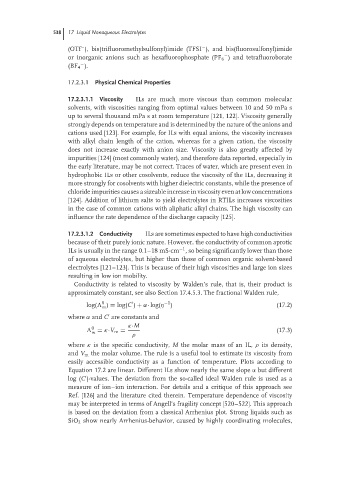Page 564 - Handbook of Battery Materials
P. 564
538 17 Liquid Nonaqueous Electrolytes
−
−
(OTf ), bis(trifluoromethylsulfonyl)imide (TFSI ), and bis(fluorosulfonyl)imide
−
or inorganic anions such as hexafluorophosphate (PF 6 ) and tetrafluoroborate
−
(BF 4 ).
17.2.3.1 Physical Chemical Properties
17.2.3.1.1 Viscosity ILs are much more viscous than common molecular
solvents, with viscosities ranging from optimal values between 10 and 50 mPa s
up to several thousand mPa s at room temperature [121, 122]. Viscosity generally
strongly depends on temperature and is determined by the nature of the anions and
cations used [123]. For example, for ILs with equal anions, the viscosity increases
with alkyl chain length of the cation, whereas for a given cation, the viscosity
does not increase exactly with anion size. Viscosity is also greatly affected by
impurities [124] (most commonly water), and therefore data reported, especially in
the early literature, may be not correct. Traces of water, which are present even in
hydrophobic ILs or other cosolvents, reduce the viscosity of the ILs, decreasing it
more strongly for cosolvents with higher dielectric constants, while the presence of
chloride impurities causes a sizeable increase in viscosity even at low concentrations
[124]. Addition of lithium salts to yield electrolytes in RTILs increases viscosities
in the case of common cations with aliphatic alkyl chains. The high viscosity can
influence the rate dependence of the discharge capacity [125].
17.2.3.1.2 Conductivity ILs are sometimes expected to have high conductivities
because of their purely ionic nature. However, the conductivity of common aprotic
−1
ILs is usually in the range 0.1–18 mS·cm , so being significantly lower than those
of aqueous electrolytes, but higher than those of common organic solvent-based
electrolytes [121–123]. This is because of their high viscosities and large ion sizes
resulting in low ion mobility.
Conductivity is related to viscosity by Walden’s rule, that is, their product is
approximately constant, see also Section 17.4.5.3. The fractional Walden rule,
0
−1
log( ) = log(C ) + α· log(η ) (17.2)
m
where α and C are constants and
κ·M
0
= κ·V m = (17.3)
m
ρ
where κ is the specific conductivity, M the molar mass of an IL, ρ its density,
and V m the molar volume. The rule is a useful tool to estimate its viscosity from
easily accessible conductivity as a function of temperature. Plots according to
Equation 17.2 are linear. Different ILs show nearly the same slope α but different
log (C )-values. The deviation from the so-called ideal Walden rule is used as a
measure of ion–ion interaction. For details and a critique of this approach see
Ref. [126] and the literature cited therein. Temperature dependence of viscosity
may be interpreted in terms of Angell’s fragility concept [520–522]. This approach
is based on the deviation from a classical Arrhenius plot. Strong liquids such as
SiO 2 show nearly Arrhenius-behavior, caused by highly coordinating molecules,

